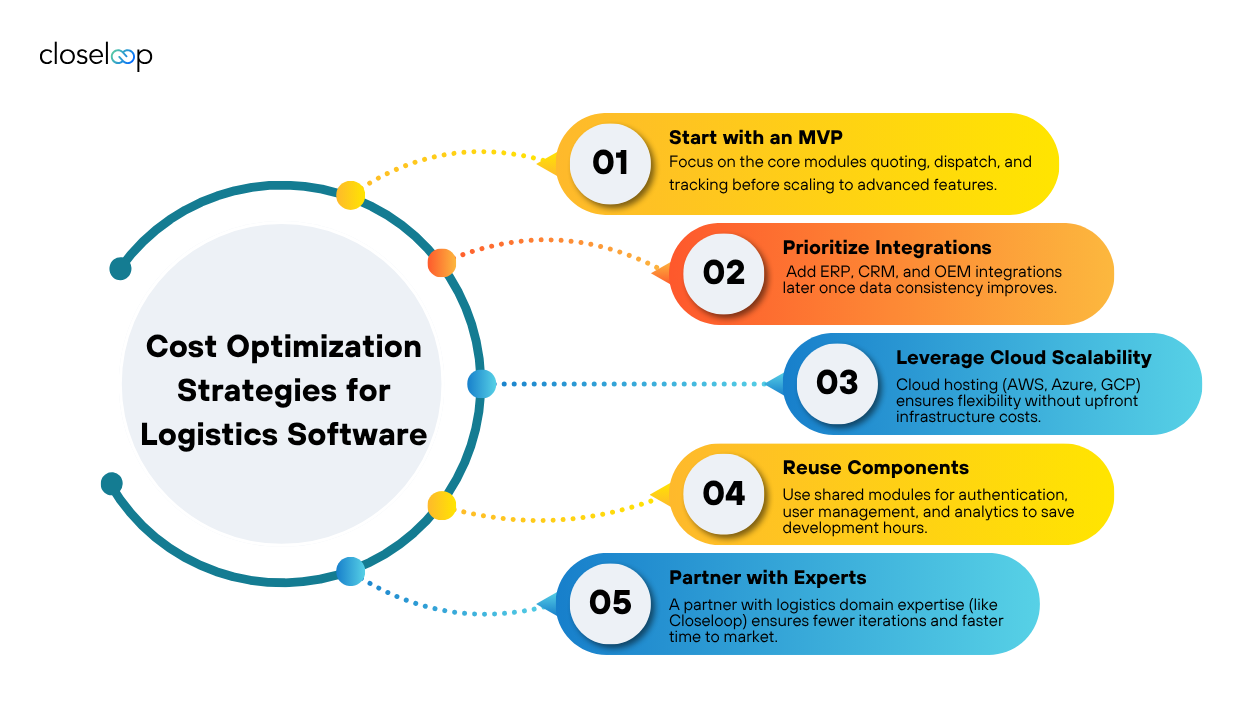Global logistics is transforming faster than ever. Real-time visibility, automation, and AI integration are no longer optional; they define competitive advantage. Yet, many logistics enterprises still rely on spreadsheets or outdated TMS tools, limiting scalability and cost efficiency.
According to Fortune Business Insights, the global logistics software market was valued at USD 15.12 billion in 2024 and is expected to reach USD 27.88 billion by 2032, growing at a CAGR of 8% (source: Fortune Business Insights, 2024).This rapid growth reflects a key trend: custom logistics software development has become mission-critical for companies that aim to optimize fleet operations, route planning, and cost visibility.
Why Businesses Invest in Custom Logistics Software
Every logistics leader wants visibility, efficiency, and control yet many operate with disconnected systems. The result? Manual errors, cost leakages, and delayed decision-making.
Common challenges that drive modernization:
-
Dependence on spreadsheets or legacy TMS/WMS platforms
-
Lack of unified view across operations
-
No real-time visibility of deliveries or fleet utilization
-
Inefficient route planning and driver allocation
-
Poor data accuracy and compliance gaps
-
Missed cost optimization opportunities
Closeloop’s work with D2D Global exemplifies this transformation. D2D, a North American haul-away logistics operator, managed 20 car carriers across multiple states but relied entirely on Excel for quoting, route planning, and cost calculations. Closeloop built D2DLoop, a cloud-hosted, AI-ready logistics platform that centralized data, automated quoting, and delivered real-time operational analytics.The outcome: quoting accuracy improved by 25%, planning effort dropped by 40%, and customer quote revisions reduced by 50%.
Factors That Influence Logistics Software Development Cost
Building logistics software isn’t one-size-fits-all. The total cost depends on the system’s purpose, scale, and technical architecture.
|
Cost Driver |
Description |
Impact on Budget |
|
Project Scope & Complexity |
Number of modules (e.g., TMS, WMS, route optimization, tracking) |
+20–40% |
|
AI & Automation Features |
Predictive planning, anomaly detection, auto-cost modeling |
+15–25% |
|
Integrations |
ERP, OEM, GPS/IoT, CRM, EDI |
+10–30% |
|
Cloud Architecture |
AWS/Azure setup, scalability, hosting |
+10–15% |
|
Security & Compliance |
Role-based access, audit logs, data encryption |
+10% |
|
User Roles & UX |
Custom interfaces for drivers, dispatchers, and finance |
+10–20% |
|
Region of Development |
US vs. offshore development |
Cost variance up to 40% |
Cost Breakdown by Type of Logistics Solution
Different logistics operations require different platforms each with its own cost considerations. Below is a structured breakdown based on Closeloop’s project experience and industry benchmarks.
|
Solution Type |
Purpose |
Estimated Cost Range (USD) |
Closeloop Example |
|
Transportation Management System (TMS) |
Manage quoting, dispatch, and cost optimization |
80,000 – 250,000 |
D2D Global’s D2DLoop platform D2D Global - Logistic Document |
|
Warehouse Management System (WMS) |
Inventory, order tracking, warehouse automation |
70,000 – 200,000 |
GSC’s warehouse integration with POD app GSC - Logistic Document |
|
Fleet Management Software |
Track fleet, fuel, maintenance, and driver performance |
100,000 – 300,000 |
D2DLoop’s cost modeling module |
|
Yard Management System (YMS) |
Optimize vehicle yard and OEM collaboration |
120,000 – 400,000 |
ACG’s AutoTrace platform ACG - Logistic Document |
|
Proof of Delivery (POD) / Last-Mile App |
Digital proof capture, offline workflows |
50,000 – 150,000 |
GSC POD app GSC - Logistic Document |
Note: Costs depend on complexity, integration, and scale. Enterprise-grade systems often extend beyond these ranges when AI and EDI are integrated.
Feature-Wise Cost Breakdown
Every logistics software project involves a unique mix of modules. Below is an approximate breakdown of feature-level costs:
|
Feature / Module |
Functionality |
Cost Range (USD) |
|
Real-Time Tracking & Telemetry |
GPS, route visibility, live driver status |
10,000 – 25,000 |
|
Automated Quoting & Cost Engine |
Dynamic pricing, rule-based cost templates |
8,000 – 15,000 |
|
Route Optimization (AI-based) |
Predictive routing, shortest path algorithms |
15,000 – 30,000 |
|
Fleet & Driver Management |
Performance tracking, scheduling |
12,000 – 20,000 |
|
Warehouse/Yard Automation |
Real-time asset visibility and task planning |
15,000 – 40,000 |
|
Compliance & Audit Trails |
Regulatory workflows, timestamped logs |
10,000 – 20,000 |
|
Integrations (ERP, CRM, OEM, IoT) |
Data synchronization via API/EDI |
10,000 – 30,000 |
|
Mobile App (Driver/Yard) |
Offline-first design, barcode scanning |
20,000 – 50,000 |
|
Analytics Dashboard |
Real-time reporting, KPIs, cost variance |
8,000 – 20,000 |
Closeloop in Action: The D2DLoop platform automated rule-based quoting and real-time route creation, reducing quoting time by 30% and boosting cost accuracy by 25%. Similarly, GSC’s Proof of Delivery (POD) app digitized manifests and barcode workflows, eliminating 100% of paper logs and speeding up deliveries by 60%.
Industry-Wise Cost Variation
Costs can differ significantly by logistics segment, based on operational complexity, compliance, and integration requirements.
|
Industry Segment |
Focus Areas |
Estimated Cost Range (USD) |
Closeloop Case Study |
|
Automotive Logistics |
OEM integration, EDI, audit logs, yard automation |
120,000 – 400,000 |
ACG’s AutoTrace – unified yard system ACG - Logistic Document |
|
Grocery & Retail Distribution |
Last-mile delivery, returns tracking, offline access |
60,000 – 180,000 |
GSC’s POD app – paperless digital proof GSC - Logistic Document |
|
Haul-Away / Transportation |
Route optimization, cost modeling, AI insights |
100,000 – 250,000 |
D2DLoop – centralized dispatch & cost modeling D2D Global - Logistic Document |
|
E-Commerce Fulfillment |
Real-time tracking, warehouse automation |
90,000 – 220,000 |
Based on Closeloop’s modular logistics stack |
|
Cold Chain & Pharma |
IoT temperature monitoring, regulatory validation |
120,000 – 300,000 |
Similar frameworks built by Closeloop for healthcare logistics |
AI, Automation, and Integration Costs
AI and automation are the biggest differentiators in 2025’s logistics technology landscape. They enhance cost predictability and operational intelligence but they also influence your development budget.
AI-Powered Features That Add Value:
-
Predictive route planning (reduces fuel costs by 10–15%)
-
Dynamic pricing and cost modeling
-
Anomaly detection for delivery delays
-
Generative AI for reporting and decision insights
-
Predictive maintenance alerts for fleet health
Integration-Centric Costs:
-
ERP / SAP / Oracle integrations
-
CRM connectors for sales and dispatch visibility
-
IoT & GPS tracking modules
-
EDI for OEM and vendor data sync
In Closeloop’s D2DLoop and AutoTrace implementations, AI and EDI integration
accounted for nearly 25–30% of total build cost but these same modules
generated measurable ROI in reduced fuel usage, automated compliance, and data
accuracy improvements.
Also Read: Logistics Software Development Guide: Types, Features, Industry Solutions & Benefits
Cost Optimization Strategies for Logistics Software
You can control cost and maximize ROI with strategic planning. Closeloop typically recommends a modular, phase-wise approach.

1. Start with an MVP Focus on the core modules quoting, dispatch, and tracking before scaling to advanced features.
2. Prioritize Integrations Add ERP, CRM, and OEM integrations later once data consistency improves.
3. Leverage Cloud Scalability Cloud hosting (AWS, Azure, GCP) ensures flexibility without upfront infrastructure costs.
4. Reuse Components Use shared modules for authentication, user management, and analytics to save development hours.
5. Partner with Experts A partner with logistics domain expertise (like Closeloop) ensures fewer iterations and faster time to market.
Real ROI: Closeloop’s Case Studies in Cost Efficiency
D2D Global – Haul-Away Logistics Platform (D2DLoop)
-
Centralized dispatch, quoting, and compliance
-
30% faster quoting, 40% less planning time
-
Scalable AI-ready architecture on AWS
-
Result: Improved profitability and OEM trustD2D Global - Logistic Document
Grocery Supply Company – Proof of Delivery (POD) App
-
Offline-first driver app using Flutter
-
100% paperless proof capture, 60% faster processing
-
ERP integration for real-time route visibility
-
Result: Improved accountability, zero delivery disputesGSC - Logistic Document
ACG – AutoTrace Yard Management System
-
EDI integration with OEM systems
-
Mobile-enabled VIN tracking and damage logging
-
95% reduction in manual data entry, 100% service accuracy
-
Result: Recognized by OEMs like General Motors for real-time transparencyACG - Logistic Document
Together, these projects reflect how Closeloop delivers cost-efficient digital transformation by aligning technology with operational workflows, not just feature sets.
How to Estimate Your Own Logistics Software Budget
Here’s a quick 4-step framework you can use:
-
Define Your Objectives: What problems are you solving visibility, compliance, or automation?
-
List Your Modules: Identify core vs. optional features.
-
Consider Integrations: ERP, IoT, or AI will influence your cost and timeline.
-
Plan for Scalability: Choose cloud-native architecture for long-term ROI.
Pro Tip: Closeloop offers custom consultations to help you scope
logistics
software development costs accurately from MVP to full enterprise-grade
deployment.
Read Now: AI Innovations in Logistics and Transportation for 2025
Conclusion
The cost to build a custom logistics software solution can range from $80,000 to $400,000+, depending on complexity, integrations, and automation depth. But cost is only part of the equation.
The real question is, how much value can your logistics platform generate in efficiency, compliance, and visibility?
Closeloop’s experience with clients like D2D Global, GSC, and ACG shows that well-engineered custom software can deliver measurable gains reducing manual effort by 40–95%, improving accuracy by 25–100%, and enhancing customer trust through real-time visibility.
If your logistics business is ready to modernize its operations, build scalability, and gain real-time control, Closeloop Technologies can help you architect the right solution efficiently and strategically.
Talk to our logistics software experts to get your detailed cost estimate today.
Start the Conversation
We collaborate with companies worldwide to design custom IT solutions, offer cutting-edge technical consultation, and seamlessly integrate business-changing systems.
Get in TouchUnlock the power of AI and Automation for your business with our no-cost workshop.
Join our team of experts to explore the transformative potential of intelligent automation. From understanding the latest trends to designing tailored solutions, our workshop provides personalized consultations, empowering you to drive growth and efficiency.
Go to Workshop DetailsExplore Our Latest Articles
Stay abreast of what’s trending in the world of technology with our well-researched and curated articles
View More InsightsLogistics Software Development Guide: Types, Features, Industry Solutions & Benefits
The logistics and transportation industry is evolving faster than ever. It’s no longer...
From Hurdle to Success: Conquering the Top 5 Cloud Adoption Challenges
Cloud adoption continues to accelerate across enterprises, yet significant barriers persist....
Gen AI for HR: Scaling Impact and Redefining the Workplace
The human resources landscape stands at a critical inflection point. Generative AI in HR has...
The AI Procurement Revolution: Why Generative AI Is Your 2025 Game-Changer
Procurement departments are experiencing their most significant transformation since the...




